Sizes Of Solar-PV Systems
Understanding Residential System Sizes in South Africa: A 2025 Perspective
South Africa’s residential landscape is evolving, shaped by economic pressures, energy challenges, and shifting demographics. As of April 9, 2025, the most common residential system sizes—referring to the physical dimensions of homes and the energy systems that power them—are influenced by a complex interplay of factors. These include the current prime lending rate, the economic climate, persistent loadshedding, cable theft, and the realities of average household sizes and middle-class income brackets. This article explores how these elements define the residential systems South Africans rely on today.
South Africa’s economic climate in 2025 remains challenging, with slow growth, high unemployment, and inflation eroding purchasing power. The prime lending rate, a key determinant of mortgage affordability, has seen fluctuations in recent years. As of early 2025, it hovers around 11.25%, following a series of cuts from its 2024 peak of 11.75%. While these reductions offer some relief, borrowing costs remain elevated compared to pre-pandemic levels, impacting the size and type of homes middle-class families can afford.
For the middle class—typically defined as households earning between R5,000 and R20,000 per month in nominal terms—financing larger homes has become tougher. High interest rates increase monthly repayments, pushing many to opt for smaller properties. Data from past trends shows a long-term decline in full-title stand sizes, dropping from 1,063 square meters in the early 1970s to around 552 square meters in the 2015-2019 period. Today, this trend persists, with sectional title units (apartments and townhouses) and homes averaging 150-160 square meters becoming the norm. These smaller systems align with tighter budgets and the need to minimize debt exposure in an uncertain economy.
Loadshedding and Cable Theft: Energy System Adaptations
Power interruptions, driven by loadshedding and cable theft, have fundamentally altered residential system preferences. Loadshedding, though improved since its peak in 2023 (when outages totaled 289 days), remains a concern, with occasional disruptions still affecting households. Cable theft exacerbates this, particularly in urban areas, where stolen infrastructure delays repairs and deepens energy insecurity.
As a result, middle-class households are increasingly integrating alternative energy systems into their homes. Solar power, paired with battery storage, has become a popular residential system size solution. Common setups range from 5kW to 10kW solar photovoltaic (PV) systems, capable of powering an average home’s essential loads—lights, appliances, and Wi-Fi—during outages. A 5kW system, often costing R100,000 to R150,000 including batteries, suits homes of 100-150 square meters, while 10kW systems (R200,000-R300,000) cater to slightly larger residences up to 200 square meters. These sizes reflect a balance between affordability and the need for energy independence, driven by the unreliability of the national grid. Government incentives, like the solar panel tax rebate introduced in 2023, further encourage this shift, though upfront costs remain a hurdle for many.
Household Size and Middle-Class Income Dynamics
The average household size in South Africa is around 3.3 to 3.5 people, a figure that has gradually declined due to lower fertility rates and changing family structures. For the middle class, this translates into demand for homes with two to three bedrooms, typically ranging from 80 to 160 square meters. Larger families or multigenerational households, more common in rural areas or among lower-income groups, are less representative of this segment.
Income brackets paint a stark picture of affordability. Adjusted for inflation since 2016, the middle class has lost significant purchasing power—estimated at R10,000 per month in real terms by 2023 analyses. In 2025, a household earning R15,000 monthly (a midpoint in the middle-class range) faces squeezed disposable income after accounting for rising food, transport, and energy costs. This limits their ability to invest in larger homes or expansive energy systems. Consequently, compact residences with efficient layouts dominate new developments, particularly in urban hubs like Gauteng and the Western Cape, where land scarcity drives densification. Townhouses and cluster homes, averaging 100-120 square meters, are increasingly marketed as affordable yet practical options for this demographic.
Navigating Challenges and Future Trends
South Africa’s residential system sizes in 2025 reflect a nation adapting to adversity. Economically, high lending rates and a sluggish recovery constrain home sizes, while loadshedding and cable theft push households toward smaller, self-sufficient energy setups. The middle class, with its modest household sizes and strained incomes, gravitates toward residences that balance cost, space, and resilience. Developers are responding with innovative designs—think two-bedroom sectional titles with rooftop solar—or co-buying schemes, where families pool resources to afford slightly larger properties.
Looking ahead, these trends may deepen. If economic growth remains below 1% (as forecasted by some analysts), and power reliability doesn’t fully stabilize, smaller homes with integrated renewable energy could become the standard. For now, the most common residential system sizes—both in square footage and energy capacity—tell a story of pragmatism, shaped by South Africa’s unique challenges and the middle class’s determination to thrive within them. At 150 square meters with a 5kW solar setup, the typical middle-class home embodies this resilience, a modest yet forward-looking response to an unpredictable landscape.
Where Are You In Your Solar Journey
Researching

Ready For Quotes

Already Installed

Contact Us
Contact
+27 (0) 71 087 6723
info@solarcentral.co.za
Address
210 Amarand Avenue, Waterkloof Glen
Pretoria, South Africa
Schedule
24 Hours / 7 Days Open
Office time: 10 AM - 5:30 PM
Platform
get in touch
Ready to Get Started
Please fill out this form and we will get in touch with you shortly.
